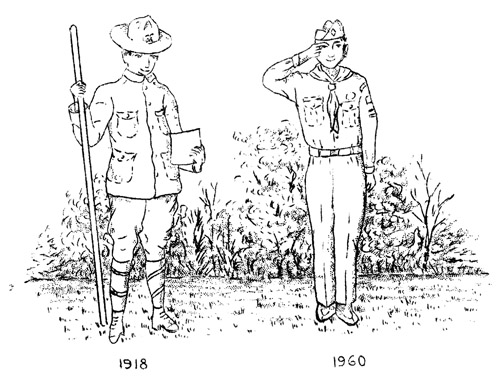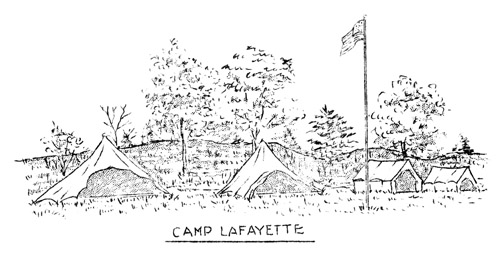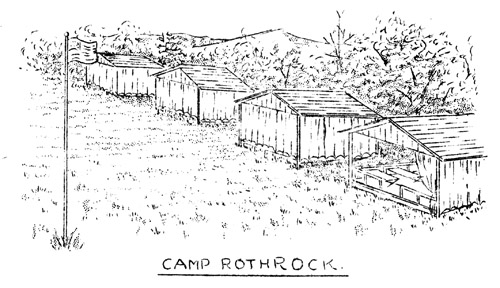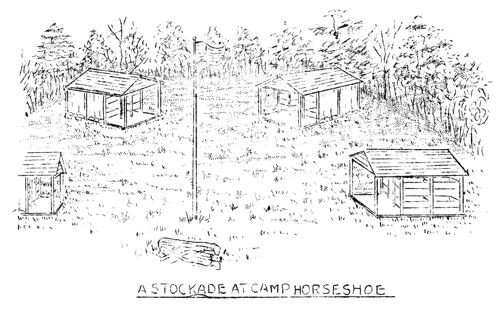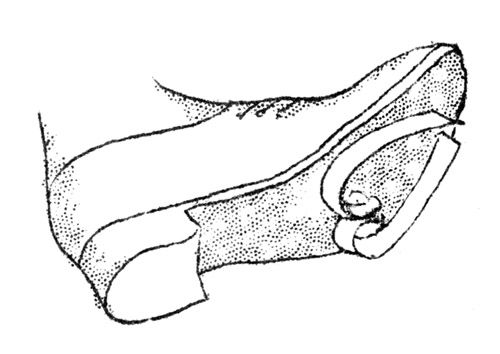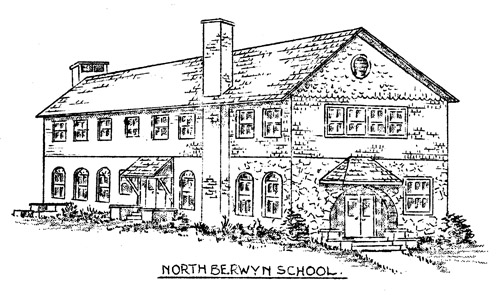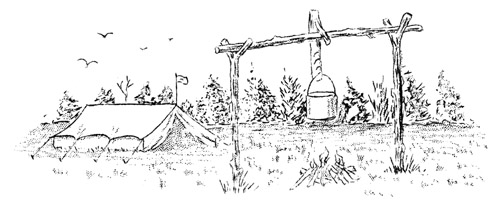|
Home : Quarterly Archives : Volume 11 |
Tredyffrin Easttown Historical Society |
|
Source: April 1960 Volume 11 Number 1, Pages 2–13 Boy Scouts of Berwyn In September, 1918, Miss Ida Channell, Principal of Berwyn Grammar School, inquired of the pupils if any one knew of someone who could organize a Scout troop in Berwyn, John Farley, a pupil, mentioned the fact that his neighbor, Franklin W. Wandless, had attended several Scout meetings in Philadelphia before coming to Berwyn. Miss Channell contacted Mr. Wandless and suggested that he organize a troop in Berwyn. As the result of an announcement made in the school that a Scout troop was to be started, enough boys registered to warrant the formation of a troop. On advice from the Philadelphia headquarters, information regarding the procedure necessary to form a troop was obtained from the national office of the Boy Scouts of America located at 200 Fifth Avenue, New York City, N.Y.
The Troop was organized immediately with the following:
The Charter Members of the Troop were: In October of 1918, during the First World War, at a bond rally held at the Berwyn Theatre, the Troop received as a prize a German helmet for selling United States Victory Bonds. The presentation was made by Mr. Alfred Edward Newton, bibliophile, of Daylesford.
The Troop by this time had obtained its uniforms. The badges, insignia, etc., were obtained from the Philadelphia Council located on Walnut Street east of Broad Street. On one occasion, while obtaining supplies, the Scoutmaster had the pleasure and honor of meeting and shaking hands with Sir Robert Baden-Powell, the founder and chief of the Boy Scouts of Great "Britain, who was visiting the Philadelphia Council. Troop meetings were held in the old Library building located on the lot at Bridge and Lancaster Pike near the Grammar School. The Library building was demolished and the lot is now occupied by the Acme supermarket. In December, 1918, a charter was received from the New York headquarters of the Boy Scouts of America authorizing the Berwyn Troop No. 1 as a member of the Scout organization, dated December 11th, 1918. To become a Scout a boy had to be not less than twelve years of age, take the Scout oath, and pass the Tenderfoot test. It was not long before some became Second-class Scouts, and then First-class Scouts who progressed to merit badge status. Many merit badges were awarded. The Troop was very active, participating in hikes, games, nature-study trips, and drills. Since the Troop was a community project and had no sponsors, the Troop Committee acted in that capacity. As the need arose the Troop Committee also became the Court of Honor and they examined the boys on advance in rank and on qualifications for merit badges. In 1919, the Chester County Council was established with Mr. Arthur Shuck as chief executive of the County, and it was shortly after this that the troops in the County were renumbered. Berwyn Troop No. 1 became Berwyn Troop No. 11. In 1919 the County Council established the first summer Scout camp at Icedale near Honeybrook on the Brandywine Creek. It was named Camp Lafayette. The Berwyn Troop attended this camp with twelve Scouts and the Scoutmaster for one week.
Camp Lafayette In 1921 the County camp was moved to Carlisle, Pa., on Laurel Lake, and the camp was named Rothrock. While Camp Lafayette was composed of large army tents, one for each troop, Camp Rothrock was composed of small buildings to accommodate one patrol, eight boys. The buildings had wooden floors and roofs with canvas side flaps. The buildings were arranged in a hollow square with the parade ground in the center. Lieutenant Clifton Lysle of Paoli Troop No. 1 was in command at Camp Rothrock at the time the Berwyn Troop attended.
Camp Rothrock A very humorous event occurred during the week our Troop was there: it seems that one Scout was a very sound sleeper and his pals in the same building had carried him on his cot to the center of the parade ground during the night. In the morning, with all the Scouts standing at attention in front of their buildings, the bugler approached the flag pole and the cot and blew the Raising of the Colors which awakened the Scout, much to the enjoyment of the entire camp. Camp Rothrock was in existence from 1921 to 1927 when the official Chester County camp was moved to Rising Sun, Maryland, and was named "Camp Horseshoe," now known as "Horseshoe Scout Reservation," which is owned and operated by the Chester County Council. When first used it was in wild country and there were some difficulties with moonshiners and trappers. In 1921 George Roberts became Assistant Scoutmaster. The Troop had two Assistant Scoutmasters until 1926 when Richard Sagebeer resigned. Meetings were held in the basement of the Great Valley Baptist Chapel located on Cassatt Avenue near Conestoga Road, Berwyn. It might be interesting to know that during the early years of the Troop activities, first and second places were awarded to the Troop in County contests with other troops. The Scouts excelled in signaling, fire-building, cooking, and knot-tying.
A stockade at Camp Horseshoe Overnight hikes were taken frequently, when eight to ten Scouts and the Scoutmaster would hike several miles and set up camp for the night. One of these hikes is still remembered. The hike ended on the Howellville Road before it enters the valley, overlooking Valley Forge, with the Trenton Cutoff to the north. Camp was set up and, after campfire with songs and stories, preparations were made for sleeping. This was done by digging a depression in the ground for shoulders and hips and rolling up in a blanket with a knapsack for a pillow. All went well until the freight trains on the Trenton Cutoff started rolling, and it seemed as though there was a train passing every five minutes - which was net conducive to sleep. However, some sleep was obtained and, to the surprise of all on awakening in the morning, we found a two-inch blanket of snow over the camp. One of the requirements of a First-class Scout was to be able to swim fifty yards. As some of the boys couldn't swim it was necessary to locate a place that would be suitable to teach them. An abandoned small quarry located in a field east of Contention Lane and north of Swedesford Road was ideal because the water was usually warm and the beach had a gradual slope. The adjacent farm was known as the Roberts place. It must be remembered that in the early twenties there was very little transportation by automobile so that for the Troop to go anywhere it was necessary to hike, except when going to camp, when a small truck was hired. Our trip to Camp Rothrock was made in a new Ford truck. One of the Scouts, for something to do on this long trip, found a loose tent spike and every time we came to a hill he would pound on the side of the truck in time with the engine pulsation, to the annoyance of the driver who was very worried by the time we arrived in camp. The driver was then informed as to what had happened, much to his relief. Soon after the Troop was formed the matter of Scouts doing a good deed was stressed. One day a fire alarm was sounded on the large steel ring in front of the Fire House on Berwyn Avenue west of Knox Avenue now used by Clark's Lawn Mower repair shop. The alarm was heard by Scouts attending school; they immediately left their classes and rushed to the fire which was in the home of Isaac Francis on Waterloo Road near Sugartown Road. They entered the house and carried out chairs, furniture, bedding, and anything else they could carry, resulting in less damage by the fire. This episode caused confusion in the school and Mr. Robbins, a School Supervisor, called on the Scoutmaster and remonstrated. As a result the Scouts were instructed not to leave school to do their good deeds. A number of First-class Scouts were interested in working for merit badges and one of these was "Firemanship," so the Scoutmaster took six or eight Scouts to a fire house on Sansom Street east of Sixteenth Street in Philadelphia where the firemen instructed them in their duties. They saw living quarters of the firemen, were instructed in sliding down the brass pole to the delight of the Scouts, harnessing the horses, starting the fire in the fire engine, and in the use of the fire-alarm signalling (sic) system, the ladders and hose, and, most important of all, how to enter a burning building. The boys enjoyed meeting the Dalmatian dog mascot. These boys passed their merit-badge test with no trouble. In order to teach the Scouts to be observant, deer-hunts were organized when light snow was on the ground. A track was made by the Scoutmaster, who had steel plates fastened to his shoes which left an imprint of a deer's hoof on the snow. The tracking was made more difficult by straddling rail fences, crossing bare places, and fording or following shallow streams. The Scouts would start fifteen or twenty minutes later and try to follow the trail. Previous to the start of the deer-hunt one Scout would take a bag of frankfurters and rolls to the place where the trip was to end. He would start a fire so that when the Scouts arrived a hearty meal of cooked deer meat (frankfurters) and rolls was enjoyed.
A number of nature-study trips were taken. Trees were identified in summer by the leaves or the number of needles in pines, in winter by the shape of the tree and its bark, Mr. Frank Burns, a member of the Troop Committee, took a number of Scouts on a trip to observe and identify birds and their habits. In the summer of 1929 a father-and-son meeting was held on the grounds in the rear of the Great Valley Baptist Chapel. Games were played, and supper, consisting of Kabobs, twist and cocoa, was cooked over open fires by the Scouts. When the meeting was over the fathers were tuckered out. In 1930, due to business activities, Mr. Wandless resigned as Scoutmaster and served on the Troop Committee. George Roberts was made Scoutmaster with Albert Brawn as Assistant. At about this time the Troop meeting place was moved to Mr. Clarence Leighton's plumbing-shop building, now used as the office of Mack Oil Company. It remained for a short time until it was moved to a room in the then unused North Berwyn School building, opposite the Tredyffrin-Easttown High School on the corner of Howellville Road and Conestoga Road. About 1933 the School Board decided to use the building. In order to accomplish the needed reconditioning, W.P.A. aid was requested. This aid could only be obtained when a community project was involved. Since the Boy Scout Troop (a community project) was using a portion of the building as a meeting place, the School Board was granted its request, and notified the Troop that they could continue to meet there permanently. While the reconstruction was in progress the Troop moved to a studio building on the George Orr place. In 1936 George Roberts resigned as Scoutmaster because of the pressure of business and Albert Brawn became Scoutmaster. He did not have an assistant, which made it necessary for him to be on the job full time with the assistance of the older Scouts.
North Berwyn School During this period eight boys from Wayne and St. Davids joined the Berwyn Troop because they were unable to join Paoli Troop No. 1 since that troop had reached its quota. In 1937 a Camporee was held in West Chester where the troops of the county competed in Scout activities. Two patrols of Berwyn Scouts participated one patrol hiked and one patrol went on bicycles from Berwyn to West Chester. It is believed this is the first time a troop went to a Camporee in this manner. Another Camporee was held at the DuPont estate at Longwood where shower facilities were provided especially for the Scouts. Later, during the same Camporee, Mr. DuPont was very much amused at the Scouts cooking their breakfasts in the rain. In 1938 Albert Brawn resigned as Scoutmaster and James Curtis was Scoutmaster from 1938 to 1940. Due to the war there were very few activities other than the Scouts collecting paper, metal, clothes, etc. There were no Camporees during the period 1941 to 1945. E. J. Lockwood became Scoutmaster in 1940 and served until 1944; his Assistant Scoutmaster was Ray Miller. During Mr. Lockwood's term the Troop took nature hikes, some trips to interesting places, and enjoyed some overnight hikes. They often went along the Horseshoe Trail. Berwyn Troop entered all County contests and always came home with many honors. Over the Washington Birthday weekend they attended the Montgomery County activities at Valley Forge. Each summer the Troop was well represented at Camp Horseshoe, and a few of the boys even went down to the camp on several occasions during the winter. In 1944 Albert T. Brawn again became Scoutmaster for the second time and served until 1948. Again he had no assistant, depending on the older Scouts for help. Mr. Brawn was employed at the Navy Yard in the Aircraft Division during the war years and it was next to impossible to get time off. However, when Mr. Brawn asked for two weeks off in order to take the Scouts to camp, the time was granted. While at camp Mr. Brawn asked his superiors for an extension of time because he was needed as a counsellor, and again his request was granted. During his administration the Order of the "Arrow" was established. This order was started in Philadelphia Council for older Scouts who were interested in camping and to instill interest in others in this branch of Scouting. There were three grades in Arrow Scouting which had the purpose of keeping the older boys active. The Scouts in Berwyn Troop No. 11 who were the first members were John McMahon, Dick Hill, Albert Brawn, and others as time progressed. In this period of the Troop the boys were very active in civic duties. In one instance they filled a large number of carboys with water from a nearby spring for persons stranded by a flood disaster. Paper, rags, metals, etc., were collected to help the war effort. There were about forty Scouts in the Troop, including three Eagle Scouts, six Life Scouts and six or eight Star Scouts. The majority of these boys were in the last years of high school so that in June, 1947, they terminated their Scout activities to go to college or to seek employment. This left a small number of Scouts in the Troop. In 1948 Evans H. Warner became Scoutmaster, and, with the help of a very active Troop Committee consisting of Mr. William Trowill, Mr. Abner Johnston, Mr. George Roberts, and Doctor Leslie Angus, the Troop was restored to its full complement of boys by 1950. During 1952 Charles Code, Jr. and Alfred Goff, Jr. became Eagle Scouts and Jon Tobiessen led his Cobra patrol to first place in the Chester County Council First-Aid meet. Three patrols received exceptional ratings in the Camporee held at Longwood Gardens in 1953. In 1952 an Explorer program was instituted in Berwyn Troop No. 11 under the leadership of Charles Code. This program was designed for boys fourteen years of age and over and was expected to be an adjunct to the Boy Scout program and not a replacement for it. The Explorers operated as a crew within the structure of the Troop unit. In 1958, in compliance with the National Council policy, the Explorers were chartered as a post and were officially separated from the Troop, but in practice they continued to share the same meeting place, equipment, and sponsors. William F. Bird, who started as a Scout during the early years of the Troop, became Scoutmaster in 1952 and served until 1953 with Evans H. Warner as his assistant. The Troop continued in its activities as it did during the previous years with Charles Code, Jr. and Alfred Goff, Jr. advancing to Eagle Scouts. The Troop and Scoutmaster attended Camp Horseshoe during the summer and also camped on a week-end during the winter. Harold Summerfield was Scoutmaster with Evans Warner as his assistant from 1953 to 1954. There were thirty-two Scouts in the Troop. The boys were busy with the usual Scout activities such as hiking, cooking, signaling, passing tests, etc. The Troop was well represented at Camp Horseshoe in the summer and some of the boys went to camp during the winter. Due to business conditions Mr. Summerfield resigned. He is now living in Allentown, Pennsylvania. In 1954 Clarence Rimel became Scoutmaster and served until 1955. The activities of the Troop remained about the same as in preceding years. The Scouts were busy with hiking, camping, tests, and attending Camp Horseshoe in the summer. The Troop produced one Eagle Scout, Jon Tobiessen, in 1954. William C. Schultz, Jr., became Explorer advisor in 1954 and served during the term of Scoutmaster Rimel who succeeded Mr. Schultz as Explorer adviser. Richard T. Schulze (sic) was Scoutmaster from 1955 to 1958 with Evans H. Warner as his Assistant Scoutmaster, There were sixty Scouts enrolled, of whom Peter Tobiessen, Ronald Jones, and David Hess were elevated in rank to Eagle Scouts. The Troop had the largest number of Scouts of any troop in Chester County. At a County Camporee the Troop received the first and second awards out of three awards given. The Troop has been well represented at Camp Horseshoe each year. One summer the Berwyn Scouts at camp made a resurvey of the Mason-Dixon Line which is not far from Camp Horseshoe, and on checking came close to the authentic line. Several winter trips to Camp Horseshoe were made. In 1956 the Berwyn Business Men's Association agreed to lend assistance to the Troop when requested. In 1958 thirteen Scouts and the Scoutmaster made a trip to the National Philmont Scout Ranch near Cimarron, New Mexico, where the Scouts camped in the Rocky Mountains. For several years the Troop has participated with other area troops in the sale of Christmas trees from which they have received funds which are being used to decorate the meeting place. In September of 1958 Robert Gilroy became Scoutmaster with Ralph Haney as Assistant Scoutmaster. Mr. Gilroy is an Eagle Scout, having attained this rank while a member of Willistown Troop No. 78. He is the present Scoutmaster of Berwyn Troop No. 11 with thirty-four Scouts in the Troop. In 1959 Lee Williams and Bruce Brunkhorst received one of the highest awards that a Scout can obtain, that of "God and Country." John Haney also became an Eagle Scout. At a District First-Aid meet, given by the Chester County Council, one patrol of Berwyn Troop No. 11 won six or seven events of the eight given. A Court of Honor was held in the Burrough's Auditorium where a number of awards were given which made it an impressive ceremony. During the summer of 1959 the Troop camped at Camp Horseshoe for two weeks where fifty-eight tests were passed by the Scouts of this Troop. The Troop is at present engaged in painting and decorating its meeting room in the North Berwyn School and expects to have it finished in the near future.
There have been approximately one thousand boys who have passed through Berwyn
Troop No. 11, of which the following have become Eagle Scouts. The men who have given their time and counsel, advice and help as Committeemen or members of the Court of Honor are Alexander Clark, Franklin Burns, Washington I. Smith, Rev. W.T. Vandever, Eugene Lang, Eric Corkhill, Sr., William Armstrong, Clarence Leighton, Charles Gibb, Abner Johnson, S. Paul Teamer, Jim Carver, Bill Pyott, William Trowill, Dr. Leslie Angus, Jim Matthews, Frank Jones, William C. Schultz, Jr. C.H. Sawyer, Jr., Alfred Goff, Sr., and others of whom we have no record. The present members of the Troop Committee are: William Jackson, Chairman; Ralph Kolze, Secretary; Lyle Haack, John Kutcheson, Robert Bruhn, Harold Brunkhorst.
|
